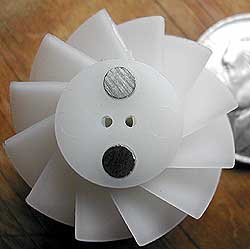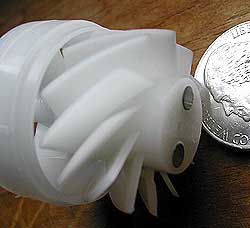One of my greatest joys in life is taking things apart. Granted, some stuff is pretty boring, not as many surprises when everything is encapsulated in surface mount chips, but every once in a while you come across something unique, unexpected, or particularly clever.


Today's clever object comes from the plumbing of a new Sears water softener. Nestled in the plastic pipe leading out of the softener is this little propeller rig. Water comes out and the propeller spins at a rate consistent with the flow. Pretty straight-forward. What's unique is the two little metal slugs in the prop, which turn out to be magnets. And, sure enough, snugged up against the pipe's outer wall in line with these magnets is a hall effect transistor.
Let's digress a moment. A transistor is lot like plumbing itself except it controls the flow of electrons. The transistor has one wire which is the "source" where electrons come in and another wire, the "drain," where the electrons would like to go. In between sits the gate, the electronic equivalent of a faucet. A little bit of electricity applied to the gate and the greater collection of electrons flow from source to drain. Switched flow.
A hall effect transistor is essentially the same except that the gate is opened/closed in the absence/presence of magnetic fields. A magnet detector if you will. In the softener's case the flowing water spins the propeller and the magnets cause the opening and closing of the hall effect transistor. Kind of like a two year old at the light switch. If we could rig it to our stereo we would hear higher frequency tones as the water rate increased.
Somewhere in the heart of the water softener is a circuit which measures this varying pulse of electrons. Most likely it counts the pulses, storing it in a chunk of memory: every ten thousand pulses (propeller revolutions) equating to a gallon of water flow. Somewhere else in this circuit is a magic number, a number which roughly correlates to the number of gallons in the softener. The circuit compares the propeller spinning count to this magic number and when they are the same it clicks a few relays, shifts a valve or two, and goes through a cleaning and regeneration cycle. Once that's done it resets the spinning prop counter to zero and starts over.
That's not the only place you'll find hall effect transistors and spinning magnets. If you have a cruise control in your car chances are that it uses something very similar. The spinning magnets are on the car's drive shaft and a hall effect transistor sends their rate of spin to another comparator, this time the magic number is the rate of spin the magnets had when you clicked the SET button on your cruise control. The computer now compares your stored rate with the current rate, adjusting the flow of gas accordingly.
Of course there's a bit more to it than turning the gas on/off whenever the two rates are different. If we did that the ride would be more like that of a Student Driver rather than the smooth response of today's modern cruise control. The circuit uses something called hysteresis. I like to think of hysteresis as the humanization of electronics. Given the task of turning a light on every time you hear a sound a person will pause for a second to verify that it really did happen, maybe even decide not do it since they just switched it a second ago. If a second passes and the sound is still there then on goes the light. Think of your last hearing test and you get the idea.
Putting hysteresis into a circuit essentially means that there is some built in slop. Nothing as subjective as you'd get with a person, more like "if the current speed falls ten percent below the set speed THEN start applying gas." With the inclusion of computers processors I suspect they use more factors than that, checking to see how fast the rate is falling or rising and cranking up the responses accordingly. Older cruise controls didn't compensate like this and that's why they'd lose it on really steep hills.
Well, thanks for joining me inside the water softener. ":^)
I've seen this too! It's cool!